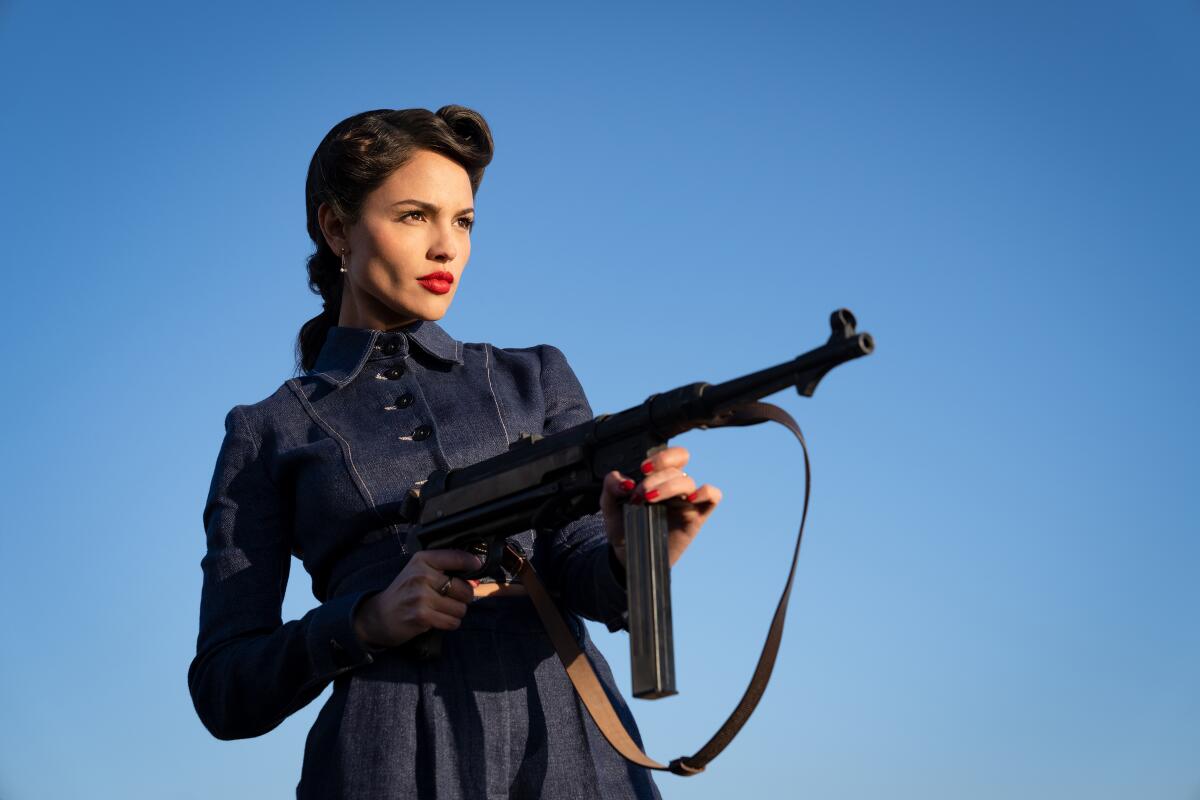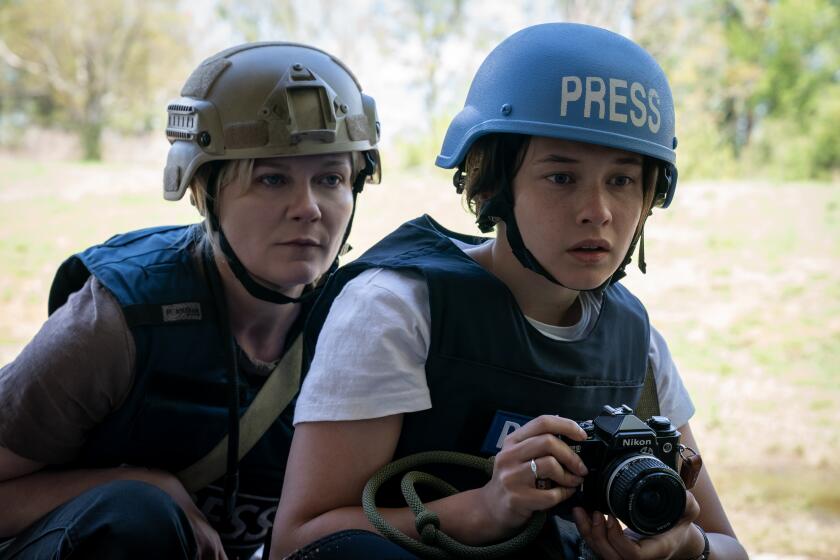How accurate is a new movie about the real-life spies who inspired Bond? We checked

- Share via
Warning: The following contains spoilers from “The Ministry of Ungentlemanly Warfare.”
Although the events of World War II have been extensively studied, details are still emerging. In fact, documents concerning an essential mission, dubbed Operation Postmaster and undertaken by the British War Office, were only recently declassified. The mission, carried out by the Special Operations Executive (SOE), is the unlikely subject of Guy Ritchie’s latest film, “The Ministry of Ungentlemanly Warfare.”
Now in theaters the film, written by Paul Tamasy, Eric Johnson, Arash Amel and Ritchie, is based on Damien Lewis’s 2014 book “Churchill’s Secret Warriors: The Explosive True Story of the Special Forces Desperadoes of WWII.” However, it takes some dramatic license in its depiction of the events.
“The story itself and the elements are true,” Amel says, noting that some characters are amalgamations to serve a two-hour narrative. “Not only was it untold history, with men on a mission against all odds who became the forerunners of James Bond, but it was a coming together of this multicultural coalition of the misfits. It wasn’t just your classical story of the British fighting the Germans.”
Operation Postmaster involved a group of special operatives, led by Gus March-Phillipps (Henry Cavill), who were tasked with destroying ships used to supply the German U-boats then terrorizing British waters. The members of the team — Anders Lassen (Alan Ritchson), Geoffrey Appleyard (Alex Pettyfer), Henry Hayes (Hero Fiennes Tiffin) and Freddy Alvarez (Henry Golding) — are based on real people. Other characters, like Nazi leader Heinrich Luhr (Til Schweiger), are fictional.
But while Ritchie infused the story with his own flair (and predilection for improvisation), the outlines of the mission itself are depicted more or less accurately.
“It was extraordinary to learn about a mission like this, which on paper was a suicide mission,” Cavill says. “It changed the course of the whole war because we essentially shut down the nasty U-boat fleet in the Atlantic. Without that happening, there could have been considerably less supplies reaching the Allies in Europe and the Americans may never have joined.”
“You can be taught this story from history and think, ‘Wow, this is fascinating,’” adds Eiza González, who plays an agent named Marjorie Stewart. “Because it is a fascinating story. But you also have to care about these people and you have to give them a personality.”
Here’s what’s true and what’s dramatized in “The Ministry of Ungentlemanly Warfare.”
Director Guy Ritchie isn’t subtle but supplies this lesser-known chapter of spycraft with verve and a cast that includes Henry Cavill and Eiza González.
The mission objective
In 1942, Winston Churchill enlisted a team of operatives to infiltrate the West African port city of Fernando Po (now Bioko) to steal three Italian and German ships, including the Duchessa d’Aosta, which supplied the German U-boats. In the film, the characters intend to destroy and sink the ships, but the plan is foiled when they realize the Duchessa’s hull has been reinforced. In reality, the mission was to steal the vessels and pretend to discover them in international waters — exactly what the team did.
“Churchill backed the mission against a lot of his senior advisors, who said the risks were too great,” Lewis says. “But he believed the upside of what would be achieved by stealing three ships was too great to miss.”
Operation Postmaster was the first mission for the group, known as No. 62 Commando. Ritchson notes that, although many factors “ helped the dominoes fall for the Allied forces … this group was one of the really important pieces of the puzzle.”
In real life, the operatives sailed two ships from Britain to Fernando Po. One was a trawling vessel, the Maid of Honour, commanded by March-Phillipps, the other a transport ship commanded by Appleyard. In the film, the action is contained to the Maid of Honour and the mission team is reduced to five agents, including Appleyard.
Onscreen, March-Phillipps leads a bloody raid on an enemy camp to free Appleyard on the way to Fernando Po. “There were certainly many attacks like that,” Lewis says. “But Appleyard was not held prisoner at that time.” Amel confirms that the raid in the film is based on the second real-life mission the group undertook, Operation Dryad, although the violence is “a nod to the mayhem and murder of subsequent missions” as no shots were actually fired.
In Fernando Po, two agents, Marjorie Stewart (González) and Mr. Heron (Babs Olusanmokun), create a diversion on the ground by hosting two parties for the Nazi officers and soldiers, as well as the Spanish harbor crew. Those scenes in the film are based on fact, although Mr. Heron is an amalgam of real-life agents.
“All of that is pretty much as it happened,” Lewis says. “The big crazy party at the end — that’s exactly what the guy did on the ground. They even had a trial party to check out that it would work. And blowing the electricity station — all of that took place.”

The James Bond factor
As seen in the movie, Ian Fleming did work for the British government and was involved with the SOE during World War II. Several years later, he was inspired to write the James Bond novels, which began with 1953’s “Casino Royale.” Lewis explains that Bond is a “photo fit” of several actual agents.
“March-Phillipps is one of the key characters and there are two or three others — all individuals that Fleming worked with,” he says. “Fleming was hands-on with Operation Postmaster. That’s absolutely true. But he also worked closely with an amazing character named Wilfred ‘Biffy’ Dunderdale. He was a high-born bon vivant, just like James Bond, and he was the secret intelligence spymaster in France prior to the war.”
March-Phillipps, who died during the next mission he undertook, wrote a spy novel himself, which Cavill discovered “in a very small article somewhere in the dark corners of the internet.”
“Had he not died during the war he might have beaten Ian Fleming to the punch,” Cavill says.
In advance of this year’s Los Angeles Times Festival of Books, we’re unveiling our Ultimate Hollywood Bookshelf. Find out which novels, memoirs and more made our list.
The Danish hammer
One of the film’s most compelling characters is Lassen, a real-life spy who went on numerous missions throughout the war and was a deadly fighter known as “the Danish hammer.” Ritchson describes him as “the most badass character in the movie and in real life” despite the fact that Lassen looked nothing like the muscled “Reacher” star.
“What so impressive about Anders is that he was this very slight man,” Ritchson says. “He didn’t look like a superhero. He was a genius tactician [and] a genius strategist. He was so inventive and creative in his pursuit of dominating the enemy or fooling the enemy or in his outright savagery.”
In the film, Lassen is a brutal killer, using a bow and arrow to take down Nazi after Nazi. He was, in fact, a skilled archer, and even campaigned to get the bow and arrow recognized as an official weapon of war in Britain. Ritchson trained with an Olympic archery coach to get the character’s physicality right.
Like March-Phillipps, Lassen died during a later mission, only two months before the war ended. His death is documented in Lewis’ book, which describes numerous missions after Operation Postmaster.
“People who read the book say they are in tears because you really get to know this guy and he is this incredible, legendary, free-spirited maverick,” Lewis says. “Alan has got his essence, as I think have all the actors.”

The body count
March-Phillipps and his team killed dozens — maybe hundreds — of enemies in the film. The action sequences do reflect real fighting techniques used by the British forces, but the number of dead Nazis during Operation Postmaster has been drastically exaggerated.
“There is quite a bit more gunfire than in the real mission,” Cavill says. “I think during the real thing not a single shot was fired, apart from when [the team] blew the anchor chain in the harbor and the Germans thought it was a bombing raid so they started firing antiaircraft guns into the sky. But they did not think there was a bunch of sneaky gentlemen stealing their boats.”
Ritchson and his stunt double Ryan Tarran helped to conceive several of the brutal fight scenes, including when Anders storms one of the ships and takes down multiple crew members with an ax. Ritchson recalls asking for 18 extras to kill in the scene even though Ritchie said he could only have 10.
“The crazier it is, the better,” Ritchson says. “I wanted everything to have life-and-death stakes, but I didn’t want it to take itself so seriously that the audience couldn’t enjoy it. The cake is the reality of this saga and the men behind it, but the icing is how much fun we can make it.”
Cavill adds that while the body count is exaggerated, it encapsulates the work these operatives did throughout the war. “What made these guys and girls so special is that they made a lot of this stuff look easy,” he says.
Carolyn Cole, a veteran L.A. Times photographer who won a Pulitzer Prize for her coverage of civil war in Liberia, breaks down the depiction of her profession in A24’s ‘Civil War.’
The real Marjorie Stewart
Marjorie Stewart was a spy and did work for the SOE, but she was not part of the Fernando Po team. And although Lewis confirms that there was a female agent on the ground, he notes that she was not, like the movie’s Marjorie, tasked with seducing Nazis. That said, seduction was certainly a tactic employed during the real-life operation.
“When they organized the party, they organized ladies to be there for the same reason,” Lewis says. “That was part of the draw — drink, food and women.”
Amel says that Stewart, who was also an actress, was an “incredible person in real life.” He wanted to include her not only because she married March-Phillipps, but because she could stand in for all of the female spies who never got their due.
“If we didn’t put Marjorie in there, we’d be forgetting all of the women that were there and the work that she did specifically on all the different missions,” Amel says. “That’s where it’s acceptable, for me, to stray from the bounds of an absolute commitment to history because contributions get forgotten.”
In the film, Marjorie distracts Heinrich with a Marilyn Monroe-like performance. The song was added on the set when Ritchie discovered that González could sing and is not based on the historical record. González did learn about Stewart’s life and work, as well as other women in the SOE, including Virginia Hall, Nancy Wake and Mata Hari.
“I was just impressed by the capabilities that they had,” González says. “Women were pivotal in these missions, and they were necessary because there were a lot of things that men couldn’t infiltrate. I genuinely encourage anyone who is fascinated by this story to read more about it. We hear about a lot of the men who made a difference, but not a lot about the women who made a difference and there’s quite outstanding stories out there.”
More to Read
Only good movies
Get the Indie Focus newsletter, Mark Olsen's weekly guide to the world of cinema.
You may occasionally receive promotional content from the Los Angeles Times.













